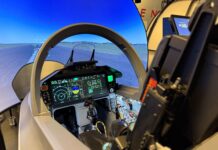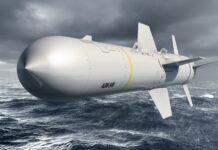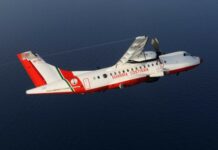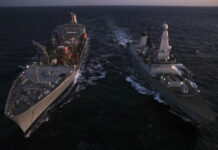Italy to Strengthen its Amphibious Power Projection Capabilities
Built under the Legge Navale fleet renewal programme, the Italian MoD and Fincantieri recently celebrated the launch of the TRIESTE Landing Helicopter Dock (LHD).
With a ceremony attended by Italy’s President of the Republic Sergio Mattarella and his daughter Laura, the latter as the the ship’s godmother, the former Minister of Defence Elisabetta Trenta, the Italian Chief of Defence, General Enzo Vecciarelli, and the former Chief of the Navy, Vice Admiral Valter Girardelli, at Fincantieri’s Castellammare di Stabia (near Naples) shipyard on 25 May 2019, the Italian MoD and Fincantieri celebrated the launch of the TRIESTE Landing Helicopter Dock (LHD), the largest warship built under the Legge Navale fleet renewal programme. Built and under fitting-out by a consortium led by the Fincantieri shipbuilding group as prime contractor, and Leonardo as combat system integrator and main sub-contractor, the contract worth €1.1Bn was awarded by the Italian MoD’s Naval Armament Directorate (NAVARM) and became effective on July 2015. The contract includes a logistic and training package with support during the shipbuilding (including courses, spare parts and technical documentation), and in-service support for the first ten years. Leonardo is the prime contractor and integrator for the combat system , and is the main contributor of equipment, together with Fincantieri, Elettronica and MBDA Italia.
With the first steel cut celebrated in July 2017 followed by the keel block laying ceremony in February 2018, the shipbuilding takes place at Fincantieri’s Castellammare di Stabia shipyard, where the ship will complete the propulsion and ship management fitting-out in order to launch the sea trails by March 2020. The ship will then move under its own propulsion to the Fincantieri’s Muggiano shipyard near La Spezia on June 2020 to complete the platform systems and combat system outfitting. Sea trials are set for August 2021, with delivery planned for June 2022.
The new ship, designed under the dual use and multi-purpose by design concepts to carry out a wide range of missions, from supporting amphibious and power projection operations at sea in national and multinational contexts, to maintaining the Community by supporting civil protection and multinational organisations in disaster relief, humanitarian, medical and evacuation operations, will also be able to perform the command functions of complex amphibious operations as a CATF/CLF (Commander Amphibious Task Force/Commander Landing Force) platform. “The new TRIESTE LHD is planned to replace the current GARIBALDI LHA platform, maintain the operational capabilities provided during its lifetime, in addition to the intrinsic amphibious, transport, medical, command and control, and support capabilities of the LHD”, said the former Chief of Italian Navy. As with the GARIBALDI LHA, which is currently replacing the CAVOUR STOVL aircraft that have undergone an important overhaul and upgrade to accommodate the Lockheed Martin F-35B STOVL aircraft, it is assumed that the LHD will perform the same operations when maintenance stops occur or when an additional deck is required for a national or international operation.

The recently published Italian Navy’s “Strategic address lines 2019-2034” document highlights the need to maintain an amphibious power projection capability to be provided at joint armed forces level through the “National Sea Projection Capability” thanks to an Amphibious Ready Group with a minimum of four platforms, including a larger platform for command and control (LHD) and the remaining platforms acting as “primary ships”. The latter are today represented by the three SAN MARCO/SAN GIUSTO class LPDs.
With an overall length of 245 metres, an overall beam of 47 metres and 36 metres at flight deck level, a construction height of 27.7 metres and a displacement of over 33,000 tonnes with a draught of 7.2 metres, the new LHD has a full length deck with a ski-jump, and a starboard-positioned island based on two separated blocks, similarly to the new Royal Navy’s QUEEN ELIZABETH class aircraft carriers, two lateral elevators connecting the flight deck with the hangar in the central-stern area, hospital, accommodation and C4ISR facilities in the bow-central areas in the lower decks and a stern well deck with forward heavy-vehicles garage with lateral and stern ramp doors for ground vehicles and naval craft.
The new LHD is classified by RINA Services according to the international pollution prevention conventions – such as those addressed in the MARPOL Convention and those not yet binding, such as those covered in the Hong Kong Convention introducing the concept of the “Green Passport”.
The new platform has spacious accommodation for a total of 1,064 people, including beds for 360 crews, while the remaining beds are divided between aviation and support, command and control, and amphibious. TRIESTE LHD will be able to ensure the support of a 600-man amphibious battalion thanks to its aviation, naval and transport capabilities. Other facilities are dedicated to the NATO Role E Hospital, and the interoperable C4ISR in NATO, European and international contests.

The new LHD features a CODOGOL propulsion (Combined Diesel Or Gas Or Electric) based on two shafts with controllable pitch propellers (CPP) and rudders provided by Fincantieri two Rolls-Royce MT30 gas turbines with 36 MW each, two MAN 20V32/44CR diesel engines with 12 MW each, and two 2.21 MW-each Marelli Motori electric motors. The electrical power generation package for both ship systems and propulsion is based on four 5.2 MW-each MAN 9L32/44CR gensets. The propulsion and electrical power supply packages are accommodated in two separated and not contiguous compartments, each hosting a gas turbine, a diesel engine, and an electric motor connected through a Renk gearbox to one shaft line, each assisted by two diesel generators. The platform is equipped with two retractable stabilising fins to support operations in high-sea states as well as two bow and one stern thrusters to facilitate operations in restricted waters. Based on the required speed and mission, the ship can reach the following maximum speeds: 10 knots with the two electric motors for amphibious flight and transit operations in environmentally restricted areas, 18 knots with the two diesel engines for transit and repositioning operations and 25 knots with the two gas turbines for high-speed repositioning. The ship`s range is 7,000 nautical miles at 16 knots.
With a maximum length of 230 metres, a beam of 36 metres and a 7,400 sqm area, the flight deck of the LHD has a port-side ski-jump, which features a 12 degrees ramp (the same like the CAVOUR STOVL aircraft carrier), and a flight deck port runway for the Lockheed Martin F-35B LIGHTNING II STOVL aircraft, together with nine landing and take-off spots (including one for SAR and two for emergencies) for Italian Navy’s EH-101, SH-90, AB-212 and future Light Utility Helicopter (LUH) in addition to large CH-47 and CH-53 helicopters and MV-22 or future national tilt-rotors, all being moved to the hangar and vice versa with two lateral elevators (14×15 metres) with a 40-tonnes payload capacity. The LHD is also fitted for unmanned air vehicle (UAV) operations including dedicated command and control capabilities and facilities. The ship’s starboard island features two separate superstructure blocks to accommodate the operational centres for ship and flight operations management, in addition to surface and air surveillance sensors and communications equipment. Each of the two superstructures blocks accommodate two of the four fixed faces (4FF) X-band STARFIRE Active Electronically Scanned Antenna (AESA) new-generation radar to ensure 360 degrees’ coverage around the ship and the long-range and ballistic-missile defence capable L-band fully-digital KRONOS Power Shield radar positioned on the forward island block, both provided by Leonardo together with the Distributed Static Staring (DSS) IRST sensors. The communications and EW mast is installed on the rear island block, together with the flight operational managing sensors. The forward and midships areas of the underneath decks accommodate the mess and various compartments, the combat operational centre, afloat C4I, and flight departments in addition to crew accommodation areas, while various compartments around the hangar perimeter are devoted to a range of uses. The hangar deck accommodates the NATO Role 2E hospital, crew accommodations and the hangar areas. The hangar has a size of 2,200 sqm (21×107 meters with a height of 7.8-10.7 meters) and can accommodate helicopters, aircraft or vehicles. The hangar is equipped with facilities for third-level maintenance on helicopters as well as dedicated facilities for the F-35B operations and support, including two 10-tonnes overhead travelling cranes. The fully-equipped NATO Role 2E hospital (expandable with sheltered solutions in the hangar) with a size of 770 sqm has operating rooms, radiology and analysis rooms, a dentist’s office, and patient rooms capable of hosting 27 seriously injured patients.

The underneath decks forward-central areas are for crew and troops accommodation. The garage deck (55×18 meters) has a 700 sqm surface and up to 235 linear metres of parking for heavy vehicles up to 62 tonnes like the ARIETE main battle tanks, while the well deck (50×15 meters) can accommodate up to four new type L23 LCM (Landing Craft Medium) with a 70 tonnes payload capability specifically built by Cantiere Navale Vittoria under Italian Navy’s requirements to enter-into-service with the new ship, as well as one LCAC and the landing craft in service with NATO and the Marina Militare. In addition to the four L23 LCMs, the organic LHD assets package include two 15 meters type FFC15 high-speed multirole boats under construction by Baglietto Defence for the programme and two-each 7.1 and 9.3 meters RHIBs. The movements between the two transport decks (hangar and garage) are assured by a 4 metres internal ramp and a 40-tonnes elevator, while the rear well deck (18×6 metres) and the starboard (6.5×5 metres) ramp doors of the same garage deck have a maximum capability of 62 tonnes. Smaller elevators for the hospital and ammunitions are available together with two 30-tonnes cranes on the flight deck for materiel, vehicles and boats embarkation/disembarkation. The hangar and garage decks have a total area of 4,500 sqm and the additional flight deck has an area of 1,500 sqm, while the C4I facilities have an area of 740 sqm. The new amphibious assault ship can also carry 2,600 m³ of F76 fuel and 2,000 m³ of F44 fuel, in addition to 600 m³ of water and 350 tonnes of munitions.
Ship Management and Combat System
The Italian Navy and NAVARM requested the industry to develop common ship management and combat system suites for all the Legge Navale’s vessels, including the PPA, LHD, LSS and UNPAV with the opportune diversities based on the unit types and different tasks. The Integrated Platform Management System (IMPS) is provided by Seastema, a Fincantieri subsidiary, and it belongs to SEASNavy, a new generation product family, while the SADOC Mk4 is the latest generation Command Management System (CMS) develop by Leonardo for the Italian Navy. The CMS has an open architecture with a modular and scalable structure to satisfy the requirement of the different types of platforms and missions; it is centred on innovative and lightweight composite-built consoles with a single large 43-inch touch-screen multifunction display, available on board in 32 units (plus one integrated on the bridge together with the same commander station used on the PPA), and which user-friendly operational reprogrammable software, processing power and database management are provided by remotely-based processing and data management centres with particular attention to cyber protection. The main bridge and the combat operational centre are equipped with five tactical tables developed by Leonardo together with Seastema and Martec, as well as large wall displays, all together with amphibious operation managing capabilities including unmanned platform and naval surface firing support (NSFS). The interoperability in naval and amphibious environments as well as in other operational scenarios require a high level of data and voice connectivity which is ensured onboard the Italian Navy’s new warships by the extended multi-standard communications suite based on Leonardo’s SWAVE family of Software Defined Radio with conformal and conventional antennas. The LHD will be equipped with an extensive integrated suite with V/UHF, HF radios, multiband (C/X/Ku and X/Ku/Ka) military and commercial SATCOM, LTE, wireless, GMDSS and tactical data Link 11, 16, 22, VMF and JREAP managed by Leonardo’s Multiple Data Link Processor (MDLP), voice (telephone, recording, broadcast, intercom and emergencies) and data (data network, large-band (LTE) wireless, Wi-Fi, video teleconference and internet protocol television), with over 50 RTX channels in addition to the data link ones and advanced cyber defence capabilities both for the IPMS and the combat system. The navigation suite includes inertial systems, GPS, WECDIS and AIS systems, as well as dual-band (‘X’ and ‘Ka’) GEM Elettronica’s GEMENI DB navigation radars.

The integrated sensors’ suite includes the same new-generation Leonardo 4 fixed-faces (4FF) X-band StarFire AESA radar used on the First-of-Class (FoC) Thaon di Revel PPA (and part of the Dual-Band – ‘X’ and ‘C’ band – Radar (DBR) suite, to be installed on the PPA’s Full capable platform to be delivered in 2024) with provisions for the ‘C’ band addition, and the new-generation Leonardo L-band KRONOS Power Shield early warning radar characterised by an AESA rotating antenna and fully digital architecture with ‘digital beamforming’ for long-range surveillance, detection and tracking of both air breath and ballistic missiles targets. These radars are integrated with Leonardo`s new SIR-M5-CA IFF system equipped with conformal antenna and electronic beam scanning, compatible with most recent NATO standards, sided by advanced transponder. The Electronic Warfare suite (EWS) is based on the same configuration designed and provided for the Italian Navy’s PPA class but tailored on LHD ship requirements. The integrated suite includes RESM (Radar Electronic Support Counter-Measure), CESM (Communication ESM) and RECM (Radar Electronic Counter-Measure) with an extremely powerful electronic attack subsystem based on solid-state AESA array with GaN (gallium nitride) technology-applied T/R modules capabilities managed by a EW C2 unit to be effective in both blue water and littoral operation, with an enhanced Maritime Surveillance and Situation Assessment through advanced features, including innovative SEI (specific emitter identification) algorithm capabilities. The EW suite is interfaced with a multi-type decoy launching system and a reaction management system (RMS) controlling the two ODLS-20 (Oto Melara Decoy Launching System) launchers for air, surface, and underwater defence.

The LHD will also share the same Distributed Static Staring (DDS) IRST EO/IR suite equipping the PPA in order to ensure 360 degrees coverage around the ship, as well as a Sitep Italia surveillance and protecting suite consisting of Multirole Acoustic Stabilised Systems (MASSs) with long-range surveillance and non-lethal weapons systems.
The air traffic and approach are managed by the Leonardo SPN-720 solid-state, low probability of Intercept (LPI) naval precision approach radar, an AN/SPN-41 Instrument Carrier Landing System (ICLS), Thales Italia TACAN with lightweight electronically scanned antenna and Calzoni visual landing aids.
The ship’s protection against air, missile and surface threats is ensured by an ILDS (Inner Layer Defence System) suite based on three 76/62mm SUPER RAPIDO Multi-feeding gun mountings in the STRALES configuration with DART guided ammunition and VULCANO long-range ammunition, each controlled by a new-generation NA-30S Mk2 fire control system with dual-band (‘X’ and ‘Ka’) radar and EO/IR suite. For short-range self-protection, Leonardo provides three remotely controlled KBA 25/80mm guns with EO/IR FCS, the first such application for the Italian Navy and foreign customers. The ship is also fitted-for but not equipped with the MBDA Italia SAAM Extended Self-Defence (ESD) air-defence system based on two vertical launching system (8 cells each) for the ASTER 15/30 on the starboard ship’s side. The underwater protection is provided by the Obstacle Avoidance System (OAS) sonar provided by Leonardo together with the BLACK SNAKE towed-array torpedo detection system (TDS) integrated with the RMS (Reaction Management System) to operate the new Mobile Jammer Target Emulator (MJTE) underwater decoys being deployed by the two OLDS-20 decoy launchers, in addition to Sonardyne International Sentinel 900 diver detection system as Leonardo subcontractor supply.
Luca Peruzzi














